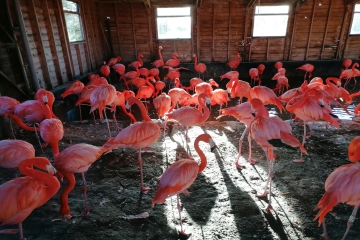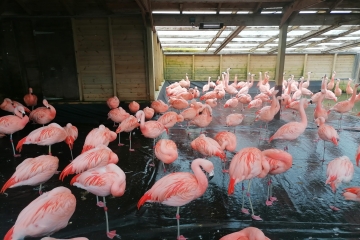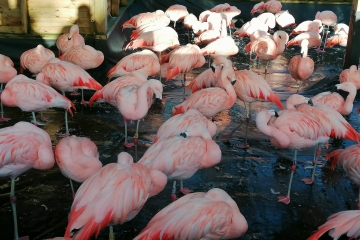Indoor flamingos- how do we know they are OK?
When you see WWT flamingos housed indoors, like they may be during an bird 'flu outbreak, it is important to ensure they are comfortable and can behave as normal. But how do we know they are OK? Find out more in this festive edition of Flamingo Diary.
It’s been another challenging year for aviculture and managing birds in the UK as the country (and indeed the wider world) deals with another Avian Influenza (bird ‘flu) outbreak. And these challenges are felt by all of the living collections staff across each WWT site that house different species of birds. WWT bird keepers work extremely hard to ensure that their feathered friends remain safe and well, and protected during times of an Avian Influenza outbreak. Flamingos are some of the most important animals that WWT cares for, so we put in a lot of effort to ensure the birds remain happy and healthy over the winter.
One of the things that you will notice on your visit is that the flamingos are likely to be inside their houses. Keeping the flamingos inside their houses helps to protect them from Avian Influenza, which is spread by direct contact between birds. But don’t worry, the birds do not seem to mind this a spell of being indoors. And we have completed some research that shows that our flamingos can behave in a varied manner when inside, just like they do when outside.
The flamingo houses have heating and lighting to mimic the natural conditions that the birds would experience if they were outside, and their spacious houses give them room to move around, bathe, preen, forage and socialise. There are behavioural and physical clues that the flamingo keepers can use understand how the birds are doing when they have to be kept inside.

Look out for good plumage colour and a chunky appearance to the birds (i.e. good body condition). And look at what they are doing. Courtship display continues when flamingos are inside, and bathing and preening can be completed because the birds have access to fresh water (around their flamingo pellet feeding areas) and in the pools in their houses. This keeps a bird’s feathers in good condition.

You can see the Caribbean flamingos (bright red birds in the top photo) playing on sand, thinking about nesting, which is an excellent natural behaviour for them to perform whilst indoors. And look to the back of the Chilean flamingos (photo of the paler pink birds above this text) and you will see a group of flamingos dancing. The birds are comfortable inside to perform all of their normal social activities.
We’ve completed research into the nocturnal activities of the flamingos, which has featured in a previous Flamingo Diary post, but this newest paper (that can be found here) measured activity and space use when inside. Using remote cameras, we recorded the behaviours of the WWT Slimbridge lesser flamingos when they were both inside and outside, to give a complete picture of a flamingo's day. We showed that the flamingos are able to move around and perform various different activities when inside just the same as they can outside, so we have some evidence that an indoor flamingo is not an unhappy flamingo. Birds were captured performing courtship display indoors, and a wide range of other natural behaviours (including nocturnal foraging, that wild lesser flamingos are documented as doing too).
You can see that the flamingos are comfortable when you move around them in their houses as they do not rush or panic to get away.
In fact, when I was fitting trail cameras in the Lesser Flamingo House for the nocturnal study, several birds actually came inside to see what was going on. You can see this in the video below.
Obviously we want to have the birds outside and enjoying their freedom and fresh air, but is more important at the moment to keep they safe and well whilst the UK (and everywhere else) deals with the current Avian Influenza situation. It is comforting to know that scientific research can provide us with an evaluation of our flamingo care to show that the birds are able to thrive in the enclosures that we provide.

Check out the pattern of partnerships when you view the Caribbean or Chilean flamingos inside. You will see that the birds have space to rest and snooze with their preferred flamingo friends. This is another example of how we can check that a flamingo is OK whilst indoors.
You might, if you are lucky on your visit, see a flamingo flock out of its house if the weather is good. We can let the birds out briefly for some exercise and a roam around if we think they would benefit from this (plus it gives their keepers a chance to do a really thorough clean of the flamingos’ housing).
Here's to more updates on the WWT flamingos in 2023. Have a very happy and healthy New Year.



